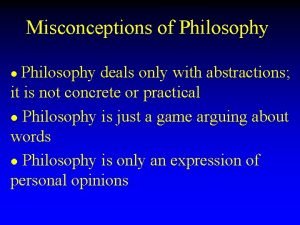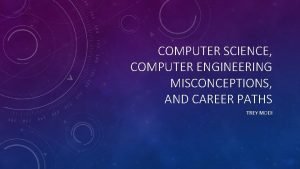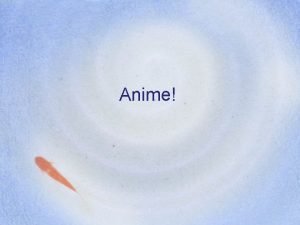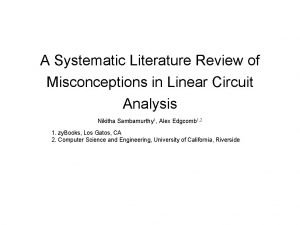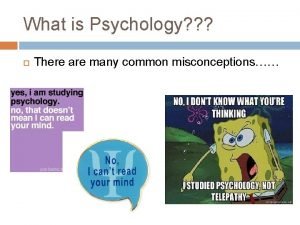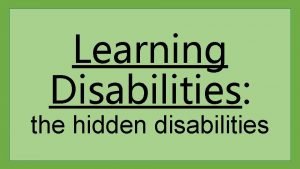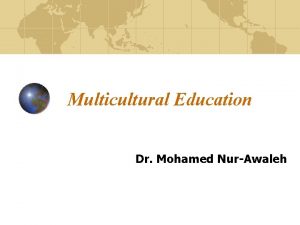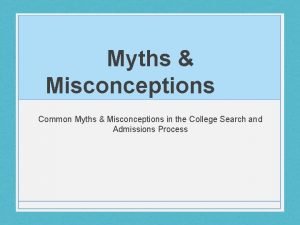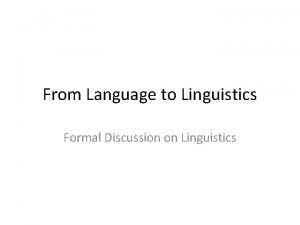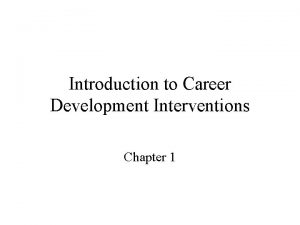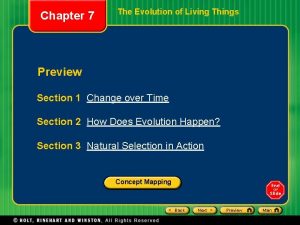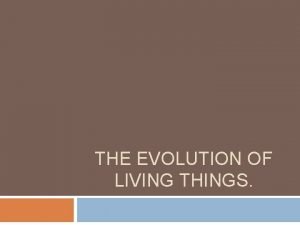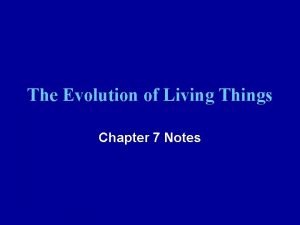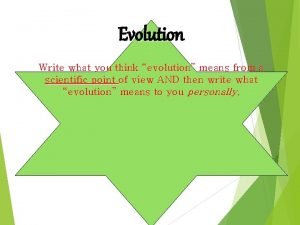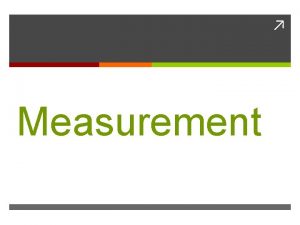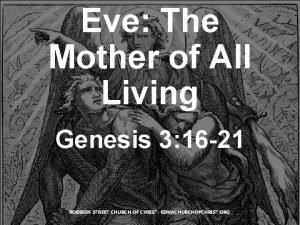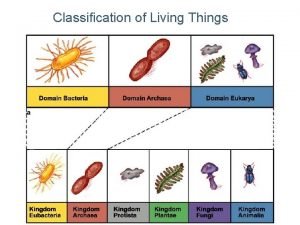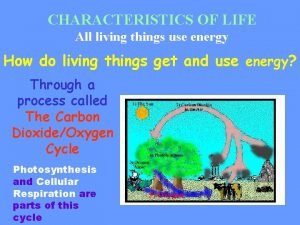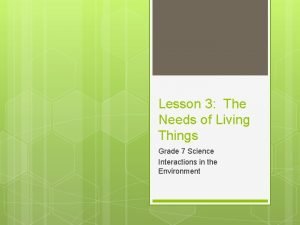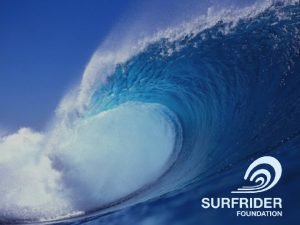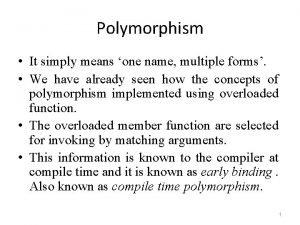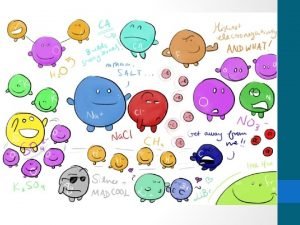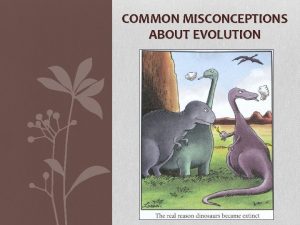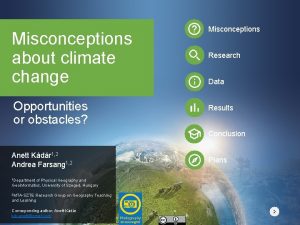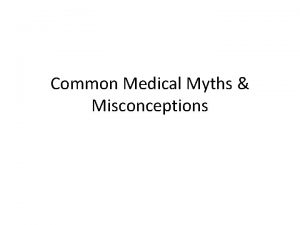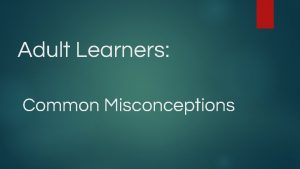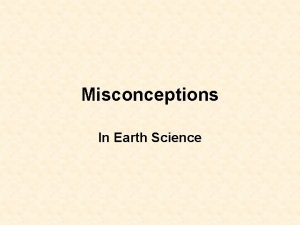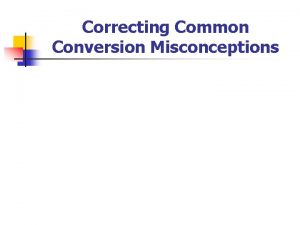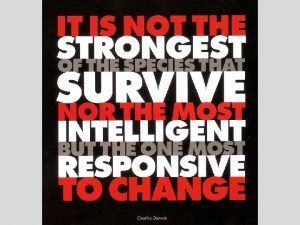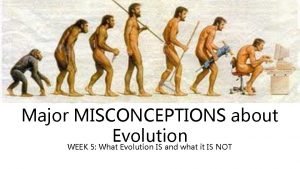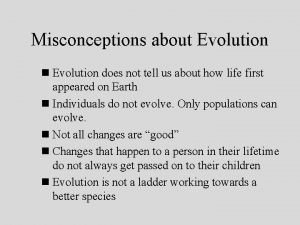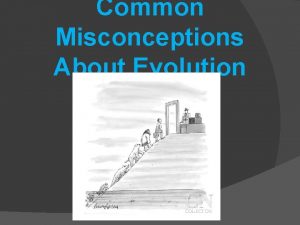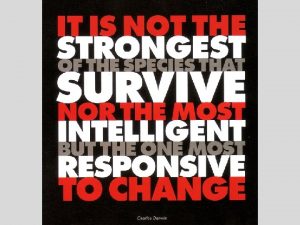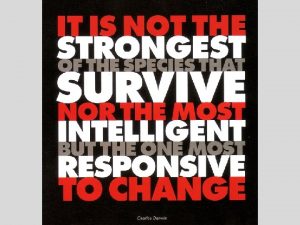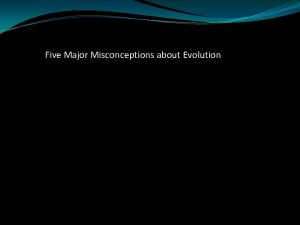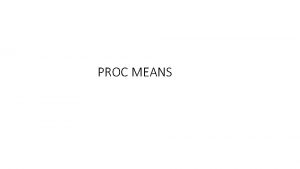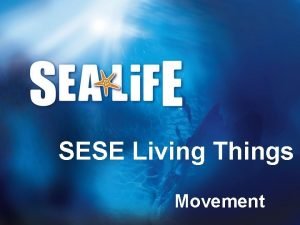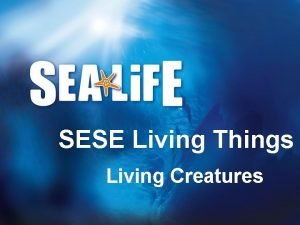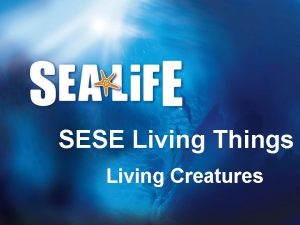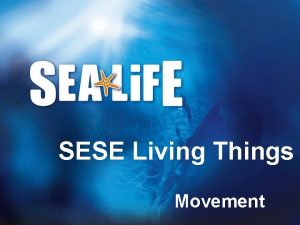EVOLUTION Many misconceptions All that it means LIVING














































- Slides: 46

EVOLUTION! ü Many misconceptions ü All that it means= ü LIVING THINGS CHANGE OVER TIME

TIME ü Origin of the universe- Big Bang? ? ü Evidence? Yes- red shift, cosmic background noise ü Age of universe= 10 -20 billion years ü Geologic time ü How old is Earth? ü Approximately 4. 6 billion years old ü Many changes can occur

Has Earth Changed? ü Yes ü Observe the continents- what do you notice? ü At one point all continents were together= PANGEA- http: //geology. com/pangea. htm ü They began to split= Laurasia(north) and Gondwanaland (south) ü How did they move?

Origin of Life? ü Spontaneous Generation ü Observation- meat left out to spoil, maggots develop ü Belief- maggots spontaneously arise ü Francesco Redi said ABSOLUTELY NOT!

Redi’s Experiment- 1668 ü 2 jarsü 1 with meat left open to air ü 1 with meat that is sealed ü Results? ü Maggots only in open jars

Redi’s Exp. Step 2 ü People argued that air was necessary for spontaneous generation ü Redi seals jars with cloth to let air in but not flies

Spallanzani’s Experiment-1775 ü People were still skeptical ü Boiled broth and placed in sealed flask ü No organisms develop- people still skeptical- no air in flask

Louis Pasteur-1859 ü Uses swan neck flask ü Boils meat broth in flask and bends neck of flask into S shape ü Air can enter but airborne microorganisms cannot- they settled in the neck ü No microorganisms grew- FINALLY- no spontaneous generation- life comes from life ü BIOGENESIS

How did life begin? ü 4. 6 bya- earth was very different ü Atmosphere of methane, carbon dioxide, nitrogen, water vapor, but no free oxygen ü Intense solar radiation, lightning, volcanic activity

First living organisms ü Possibly self replicating RNA molecules ü Eventually acquired a protective lipid coating ü Becomes something resembling today’s bacteria ü But how?

Oparin’s Hypothesis ü Ancient earth’s conditions led to spontaneous formation of organic molecules (what are the main 4? ) • These accumulated in oceans and combined into cells • http: //vilenski. org/science/notebook/unit 1 /historyoflife/oparin. html

Miller-Urey Experiment ü Simulated conditions on ancient earth ü Successfully synthesized amino acids ü Confirms Oparin’s hypothesis ü Some holes in this idea

Penn State Research- very new ü Organic compounds have been located in material in space (comets, meteorites, clouds of gas) ü Membrane forming molecules have been found in some meteorites ü Comets/meteorites bombard earth and give rise to life? ? ? Problem?

Oparin’s Idea Revisited- By PSU ü More evidence shows that first organisms were thermophilic (could thrive in earth’s early state) ü Life arises at bottom of ocean as thermophilic microorganisms

So What happened next? ü Several Different Theories ü Endosymbiotic Theory ü Jean Baptiste De Lamarck- Acquired Traits ü Charles Darwin- Natural Selection ü Devries ü Gould

ENDOSYMBIOTIC THEORY

One Idea ü Organisms change over time by adapting

Adaptations ü Structures/traits that are beneficial and serve a purpose to an organism or species ü Examples? ü Let’s go outside

ACQUIRED TRAITS- Lamarck- Late 16 th century ü Adaptations are acquired throughout and organisms life and passed on. ü Adaptations are results of organisms using or not using body parts.

Acquired Traits INCORRECT!

CHARLES DARWIN ü Takes a ride on the HMS Beagle. ü Stops @ Galapagos Islands- observes Finches ü http: //worldatlas. com/webimage/countrys /samerica/galap. htm ü Comes up with theory of Natural Selection

Darwin’s Ideas ü 2 Key Points ü Species of Organisms descended from common ancestors (adaptive radiation) ü “Descent with Modification” ü Natural Selection- best suited individuals survive and leave more offspring

DARWIN-1859 ü THEORY OF NATURAL SELECTION ü established that change occurs in organisms without respect to need ü environment determines whether or not a variation improves the chance of survival ü change occurs gradually ü never said that man evolved from apes! ü infers that man and ape had a common ancestor

THEORY OF NATURAL SELECTION Key Ideas ü OVERPRODUCTION üplants and animals over produce ülimiting factors exist to balance populations and prevent extinction due to competition ü STRUGGLE FOR EXISTENCE ücompetition exists for food and other resources üfood chains become established

ü VARIATION üindividuals in a population vary- polygenic traits (humans, etc) üthey vary whether they need to or not üsome variations have an advantage in the environment ü SURVIVAL OF THE FITTEST üthose with the variations best adapted to the environment will survive üsurvivors reproduce and pass on traits to offspring

ENVIRONMENTAL INFLUENCE ON EVOLUTION ü THE ENVIRONMENT DETERMINES IF A VARIATION WILL HAVE SURVIVAL VALUE ü THE ENVIRONMENT DETERMINES WHAT DIRECTION EVOLUTION WILL TAKE

CHANGES IN ENVIRONMENT ü MIGRATION ümovement to a new environment- when 2 gene pools mix, new traits will emerge ünew mutations give offspring greater survival value ü WITHIN THE OLD ENVIRONMENT ügeologic impacts like volcanoes üresistance to antibiotics, pesticides


üINDUSTRIAL MELANISM is a change in coloration caused by industrial pollution ü ISOLATION üa split between interbreeding groups caused by geographic/physical barriers üproduces changes in behavior, color, which prevent them from breeding

DEVRIES-1901 ü MUTATION THEORY OF EVOLUTION ü sudden changes in genes results in new types of plants and animals ü accounts for the variations suggested by Darwin ü mutations can be good, bad, or have no current value ü lethal genes which leaves organism with no chance of survival (almost always recessive)

GOULD-1972? ü PUNCTUATED EQUILIBRIUM ü agrees with Mutation Theory ü disputes Darwin’s gradualism-but not natural selection ü supports idea that evolution occurs in quick spurtsseen in fossil record all the time ü mutations accumulate over time and then a new species develops when there are too many differences between them ü there are no missing links

SPECIATION ü SPECIES is a group of organisms that are similar in structure and can mate and produce fertile offspring--all have the same number of chromosomes ü CAUSES ünatural selection --mutations üchange in environment ümigration --isolation

ü EVOLUTION OF A NEW SPECIES ü each generation inherits variations that are adaptive ü each generation forms new variations ü Gene Flow, Genetic Drift (chance) ü over a period of time, accumulations of variations will result in a new species ü if variations are unfavorable, the species will become extinct


PATTERNS OF EVOLUTION ü ADAPTIVE RADIATION üdifferent species develop from a common ancestor ü CONVERGENT EVOLUTION üorganisms with different ancestors become more alike in shape, form, behavior. . . ügenerally because they share the same environment

EVIDENCE FOR EVOLUTION ü fossil record ü Homologous structures ü vestigial structures ü embryological evidence ü biochemistry

Fossil Records ü fossils at various depths show different forms of life ü lineages of fossils of a particular group are found and quite complete ü Radiometric (radiation) dating of rock layers establishes a chemical connection between fossils

Homologies ü similarities in structure and arrangement of parts ü indicates genetic relationships of common ancestor ü suggests environmental influences on adaptations selected

Vestigial Structures ü structures of modern organisms with little to no function ü structures are often degenerate in appearance ü fossil evidence suggest structures once had a function

Embryological Evidence ü similarities in development of the embryos of various organisms into differentiation of tissues ü currently, this view point is being scientifically challenged


Biochemistry ü similarity of DNA in terms of identical genes ü similarity of hormones, digestive enzymes, ATP

EXTINCTION OF THE DINOSAURS ü METEOR ü DISEASE ü CHANGE IN ENVIRONMENT ü NEW SPECIES ADDED COMPETITION

RISE OF MAMMALS ü Mammals existed for 150 million years with dinos ü LOSS OF DINOSAURS OPEN NEW NICHES ü BETTER ADAPTATIONS ü CARE FOR YOUNG ü PLACENTA ü WARM BLOOD

EVOLUTION OF MAN ü man is an animal ü man is subject to the rules of natural selection ü man changes over time

A FINAL WORD ü most reasonable people (including the pope) understand that organisms evolve ü the argument is not over “IF” it occurs, but “HOW” it occurs ü belief that things change does not challenge religious belief
 What is the smallest living unit in all organisms?
What is the smallest living unit in all organisms? Poly means many and gon means
Poly means many and gon means Phân độ lown ngoại tâm thu
Phân độ lown ngoại tâm thu Block nhĩ thất cấp 1
Block nhĩ thất cấp 1 Thơ thất ngôn tứ tuyệt đường luật
Thơ thất ngôn tứ tuyệt đường luật Thơ thất ngôn tứ tuyệt đường luật
Thơ thất ngôn tứ tuyệt đường luật Walmart thất bại ở nhật
Walmart thất bại ở nhật Tìm độ lớn thật của tam giác abc
Tìm độ lớn thật của tam giác abc Hãy nói thật ít để làm được nhiều
Hãy nói thật ít để làm được nhiều Tôn thất thuyết là ai
Tôn thất thuyết là ai Gây tê cơ vuông thắt lưng
Gây tê cơ vuông thắt lưng Sau thất bại ở hồ điển triệt
Sau thất bại ở hồ điển triệt Aristotle vs galileo view of motion
Aristotle vs galileo view of motion Philosophy study of knowledge
Philosophy study of knowledge Common misconceptions about computer science
Common misconceptions about computer science Anime misconceptions
Anime misconceptions Misconceptions about literature review
Misconceptions about literature review Common psychology misconceptions
Common psychology misconceptions Misconceptions about learning disabilities
Misconceptions about learning disabilities Misconceptions of multicultural education
Misconceptions of multicultural education Common college misconceptions
Common college misconceptions How does linguistics differ from traditional grammar
How does linguistics differ from traditional grammar Introduction to career development
Introduction to career development Name all rays
Name all rays Chapter 7 the evolution of living things answers
Chapter 7 the evolution of living things answers Evolution of living organisms
Evolution of living organisms Chapter 7 the evolution of living things answers
Chapter 7 the evolution of living things answers Venn diagram of living and nonliving things
Venn diagram of living and nonliving things Moss living or nonliving
Moss living or nonliving Living non living dead
Living non living dead Bb or bb
Bb or bb My intuition telling me there'll be better days
My intuition telling me there'll be better days Metamorphic rocks
Metamorphic rocks Meta means change and morph means heat
Meta means change and morph means heat Biodiversity and its conservation
Biodiversity and its conservation Bio means life logy means
Bio means life logy means Seven life processes grade 4
Seven life processes grade 4 Eve the mother of all living
Eve the mother of all living 8 levels of classification for all living things
8 levels of classification for all living things Cell to tissue to organ to organ system to organism
Cell to tissue to organ to organ system to organism Life cycle of all living things
Life cycle of all living things What are the 5 basic needs of all living things
What are the 5 basic needs of all living things Are all living things based on the metric system
Are all living things based on the metric system All living things 1955
All living things 1955 One name many form is the concept of
One name many form is the concept of This means many
This means many Many buyers and sellers
Many buyers and sellers













